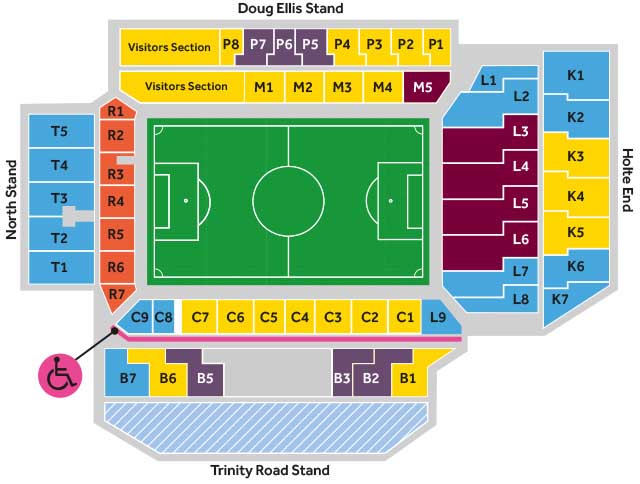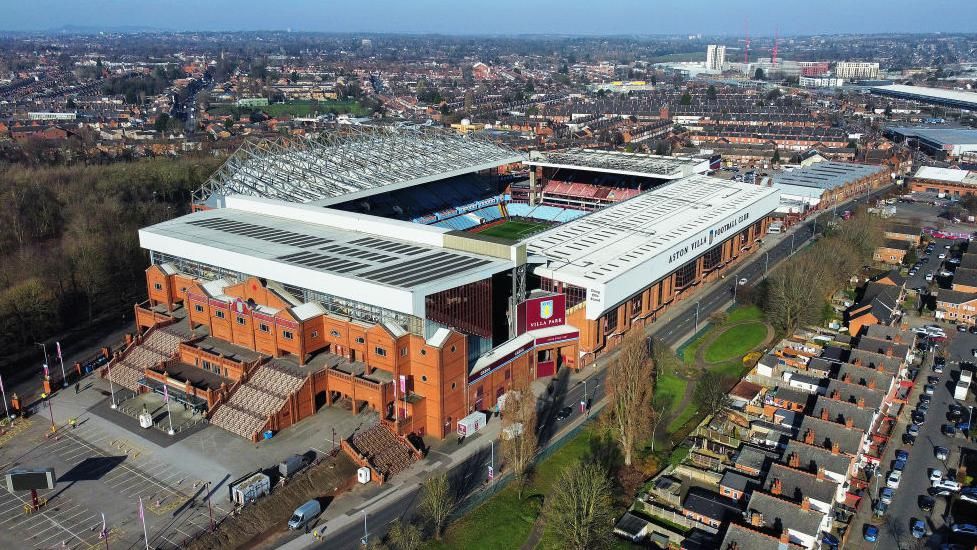Villa Park is a football stadium in Aston, Birmingham, England, with a seating capacity of 42,682. It has been the home of Premier League side Aston Villa since 1897.
The ground is less than a mile from Witton and Aston railway stations and has hosted sixteen senior England caps, the first in 1899 and most recently in 2005. Villa Park has hosted 55 Cup semi-finals FA, more than any other stadium.
| Built In: | 1897 |
| Capacity: | 42,682 |
| Home Teams: | Aston Villa F.C. |
| Ground Size: | 105 by 68 m |
Villa Park Stadium History
At the end of the 19th century, Villa Park was part of a recreation ground consisting of a football and cricket pitch, a running track, and a small grandstand. Aston Villa at the time still played their home games at Perry Barr’s ground, but in 1897 they moved to the superior Villa Park.
Before moving in, they had already built a new main stand and accompanied it with open terraces on the remaining sides. The stadium was bowl-shaped at the time and could hold about 40,000 people.
Aston Villa inaugurated their new field on April 17, 1897, with a friendly match against Blackburn Rovers (3-0).
Over the next two decades, Villa Park was gradually enlarged, and in 1913 it lost its bowl shape when the cycle track was removed. Plans were made to expand the stadium to a capacity of 130,000 but were halted by World War I.
However, work continued after the war and was completed in 1923 when the new Trinity Road Stand opened. At that time, the stadium could hold about 80,000 people.
Villa Park recorded its highest attendance in 1946 when 76,588 people attended a match against Derby County.
In the following decades, only minor changes were made, including the covering of Holte End and the redevelopment of the Witton Lane Stand in 1964.
Villa Park was one of the venues for the 1966 World Cup, hosting three group-stage matches.
The stadium underwent a next change in 1976 when a new North Stand was opened in place of Witton Lane End. However, the new position created large debts, and no further changes were made until the 1990s.
In 1993 the new Doug Ellis Stand opened, followed by the demolition and reconstruction of the Holte End. The transformation of the stadium into an all-seater stadium was completed when the north stand was fitted with seats.
Villa Park hosted three group-stage matches and one quarter-final match during Euro 1996.
In 1999 it hosted the last final of the European Cup Winners’ Cup between Real Mallorca and Lazio Roma (1-2).
In 2000, the classic 1920s Trinity Road stand was demolished and replaced with a new stand. In recent years, tentative plans have been made to expand the stadium to a capacity of 50,000 by rebuilding the north stand, but these are unlikely to be realized anytime soon.
Stadium Capacity
The stadium Capacity for this tournament is 42,682.
Villa Park Stadium Seating Plan

Notable Events & Records
The highest recorded attendance at Villa Park was 76,588, on 2 March 1946 in an FA Cup sixth-round tie against Derby County. Highest attendance in the all-seat era was 42,788 on 29 December 2009 in a Premier League game against Liverpool.
The All-Time average post-World War II attendance at Villa Park was 47,168 in the 1948–49 season; the lowest post-war average attendance was 15,237 in the 1985-1986 season.
Upcoming Events
N/A
Parking
Mainly street parking (don’t be surprised if you’re approached by kids wanting to “watch your car”), although this isn’t as plentiful as it once was due to a local residents-only parking scheme now in place on the streets around the Witton roundabout area.
On-street parking is also available in the streets around Aston train station (which you will pass if you continue on Lichfield Road towards the city center). Alternatively, free parking is available, but about 1.5 miles away (or a 30-minute walk) at the Star City leisure complex, which is also well signposted, off the M6.
Map/Location
The quickest and best way to get tickets is to visit Villa’s dedicated ticketing website. If you would rather speak to someone on the phone or are making group bookings, however, then it’s worth calling the ticket office if you’re after hospitality tickets. You may find people outside of the ground offering tickets, but these people are to be avoided.

